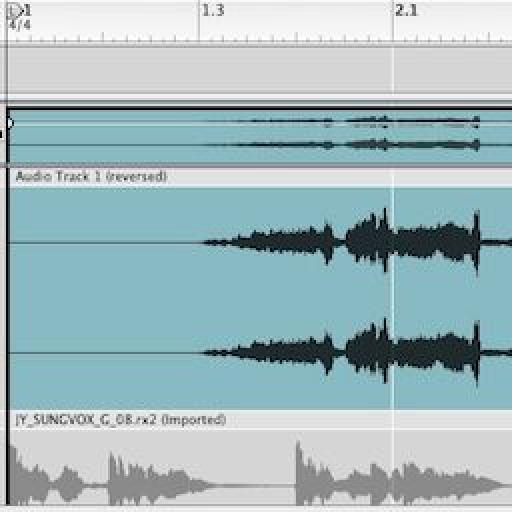我最喜欢的方法来创建特殊效果的一种方法是使用反向的延迟和混响。 这是一个伟大的方式来产生一个有点不寻常的东西,是一个伟大的方式进入世界的声音设计 。 即使初学者也可以在这里行动。
我使用本教程Propellerheads纪录,但本质上,你可以使用任何数字音频工作站,能够播放音频功能,延时和混响效果插件。 因此,多数民众赞成,以及...在这个星球上几乎所有的DAW!
01 - 选择一些音频处理
First up you’ll need to focus on a specific audio part to process. Here I am using a vocal clip as I find that these effects work very well with vocals. My part is in total isolation so everything is nice and clear but of course if you are working on a project you can complete this process on one part amongst many.
With your audio selected make sure it’s solo’d and playing in total isolation. Now is a good time to check your audio for any faults, clicks, pops or overs. The last thing you need here are any imperfections being amplified by the processing... So make sure your audio is super clean.
是孤立的,是治疗的音频
The vocal we are going to process is isolated:
[音频ID =“6187”]
02 - 扭转音频
Next open your audio file in your DAW’s audio editor. Record now features a more fully featured editor and has quite a few options for processing, one of which is the reverse function and this is exactly what we are after here!
音频拨回
Once the audio is reversed play it back to check everything is present and correct. Also double check your levels at this point and ensure that you are working with plenty of headroom, you’re going to need it when the processing is applied.
我们扭转音频准备就绪
The vocal is reversed:
[音频ID =“6185”]
03 - 应用混响或延迟
For the purpose of this tutorial I have decided to show the effect with both delay and reverb, so I have set up two send / returns in Record’s mixer. I have used Record’s excellent RV7000 Advanced Reverb to produce a very large reverb and a dedicated delay based Combinator to pump out a tape Echo pre-set in the other.
返回效果添加

效果发送记录搅拌机
The reversed audio with reverb added:
[音频ID =“6186”
... ...与立体声延迟:
[音频ID =“6188”]
随着这两个效应的成立,我是他们都能够发送我们扭转声乐。 我们得到的效果是非常特殊的,因为你可以听到在下面的片段 。 到目前为止,我们整个过程的中途,有几个步骤去之前,我们已经完成了 。
仅04 - 出口的影响
We need to export the results of our processing, and there are really two ways to go about this. You can export the whole thing, in other words the audio and effect, or you can export just the effects.
In this case I exported just the effects stream as I’m a firm believer that this method gives you much more control over the finished product and a more balanced sound in general.
Record offers some really great features for exporting very specific parts of your mix (an area from which other DAWs could learn a thing or two!). Once you have accessed the ‘Bounce mixer channels’ area you can actually home right in on the specific effects devices and just render their outputs.
记录功能齐全的出口窗口
With the isolated effects exported they are ready to be brought back into the project and mixed with the original dry parts to create the final effect.
The reverb effect in isolation:
[音频ID =“6190”]
[音频ID =“6189”]
05 - 重新导入结果,编辑,同步和混合
The bounced fx streams can now be imported into a couple of new audio tracks. Once this is complete you can go ahead and reverse all of the audio so everything is technically playing in it’s original state.
扭转和调整的轨道
The newly imported (and reversed) effects audio will now need to be moved around so that it works nicely with the original dry parts. To do this I would strongly advise you to switch off any snap mode. This will allow you to be extremely accurate with the placement and give you a better chance of getting things right.
I generally use any obvious transients to get things in line. Although the effects have often masked much of the dynamic signature you should find this pretty straight forward and the effect files are usually pretty forgiving, so you don’t have to be mathematically correct here!
现在对齐的所有曲目
Once the files are all in place you can mix their levels to strike a good balance between the dry and effected files. What you should be left with is a great reverse reverb (or delay) effect. As you have all the files you also have complete control over levels, pan and any further processing you might want to apply.

现在,所有的声音混合,以创造一个良好的总体平衡
The reverse reverb effect is mixed with the original vocal:
[音频ID =“6191”]
和延迟的效果也是参差不齐:
[音频ID =“6192”]
06 - 进一步的编辑和回收
Although the effects already sound great you can always take things a step further if you like. You can cut your effected files up, reverse sections, add automation and even more effects processing if you like. All this can be done without effecting the original files.
一些自动化添加到音频延迟
In this case I’ve automated the pan on the delay channel and added some modulation effects to the reverb. The result is a trippy collage of sound that really enhances the vocal phrase. Now go and create your own reverse effects and see what you can create!
额外的效果也加入到我们的反向混响
The final result with the extra effects and automation:
[音频ID“6193”]












 © 2024 Ask.Audio
A NonLinear Educating Company
© 2024 Ask.Audio
A NonLinear Educating Company
Discussion
Want to join the discussion?
Create an account or login to get started!